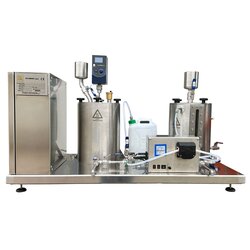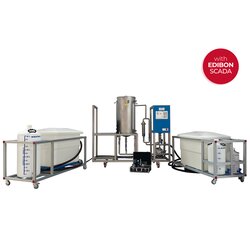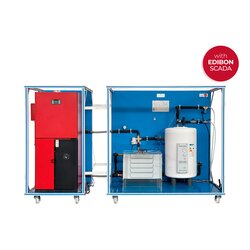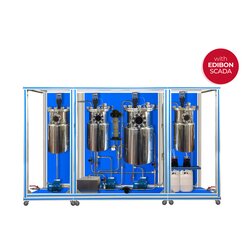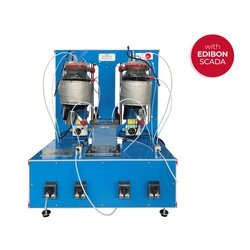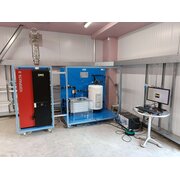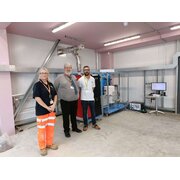Bioenergy Training Systems & Lab Equipment
Sort by
Learn more about Bioenergy Training Systems
In this section you will learn more about bioenergy training systems. We cover whish types of training systems exists, how they are used in classrooms and training centers, trends, and benefits of using hands-on lab equipment.
What are Bioenergy Training Systems?
Bioenergy training systems are educational tools and platforms designed to teach the principles and practical applications of bioenergy technologies. These systems provide hands-on experience in converting biological materials, such as plant biomass, agricultural waste, and organic residues, into usable forms of energy like electricity, heat, or biofuels.
Bioenergy training systems are used in academic settings, research institutions, and industry to develop the skills and knowledge necessary to work with bioenergy systems, focusing on sustainable energy production, environmental impact, and the integration of bioenergy into broader energy systems.
What Type of Bioenergy Training Systems Exist?
There are various types of bioenergy training systems, each focusing on different aspects of bioenergy production and utilization:
Biomass Conversion Systems:
Combustion Systems: Training equipment that simulates the combustion of biomass to produce heat and electricity, including small-scale boilers and furnaces designed for educational use.
Pyrolysis Units: Demonstrates the process of pyrolysis, where biomass is heated in the absence of oxygen to produce biochar, bio-oil, and syngas, teaching the fundamentals of thermal conversion technologies.
Biogas Production Systems:
Anaerobic Digestion Trainers: These systems simulate the anaerobic digestion process, where organic materials like agricultural waste and food scraps are broken down by microorganisms to produce biogas (mainly methane) and digestate.
Biogas Upgrading Units: Equipment that shows how biogas is purified and upgraded to biomethane, which can be used as a renewable natural gas substitute.
Biofuel Production Systems:
Biodiesel Production Kits: These kits demonstrate the process of converting vegetable oils or animal fats into biodiesel through transesterification, focusing on the chemistry and process optimization.
Ethanol Fermentation Systems: Training systems that simulate the production of ethanol from sugarcane, corn, or other biomass through fermentation, highlighting the process of distillation and purification.
Algae Bioenergy Systems:
Algae Cultivation Systems: These systems teach the cultivation of algae for bioenergy purposes, including the harvesting of algal biomass for the production of biodiesel, bioethanol, or biogas.
Photobioreactors: Simulate the controlled growth of algae in a closed environment, focusing on optimizing conditions for maximum biomass yield and energy production.
Integrated Bioenergy Systems:
Combined Heat and Power (CHP) Systems: These systems demonstrate the integration of bioenergy production with combined heat and power generation, showcasing how biomass or biogas can be used to produce both electricity and thermal energy efficiently.
Hybrid Systems: Training modules that combine bioenergy with other renewable energy sources, such as solar or wind, to explore hybrid energy solutions and grid integration.
Environmental Impact and Sustainability Assessment Tools:
Life Cycle Assessment (LCA) Software: Tools that help evaluate the environmental impacts of different bioenergy systems throughout their life cycle, from feedstock production to energy generation.
Carbon Footprint Calculators: Equipment or software that trains students to measure and analyze the carbon footprint of various bioenergy processes, promoting sustainable practices.
Why Use Bioenergy Training Systems?
Bioenergy training systems are essential for several reasons:
-
Skill Development: These systems provide practical, hands-on experience that is crucial for developing the technical skills needed to design, operate, and maintain bioenergy systems.
-
Sustainability Education: Bioenergy is a key component of renewable energy strategies aimed at reducing greenhouse gas emissions and reliance on fossil fuels. Training systems help educate future engineers and scientists on sustainable energy practices.
-
Innovation and Research: They provide a platform for testing new technologies and methods in bioenergy production, helping to drive innovation and improve the efficiency and viability of bioenergy solutions.
-
Industry Readiness: These systems prepare students and professionals for careers in the growing bioenergy sector, ensuring they have the knowledge and skills to contribute effectively to the industry.
-
Environmental Awareness: Bioenergy training systems teach the environmental impacts of energy production and encourage the development of sustainable and responsible energy solutions.
Best Practices for Using Bioenergy Training Systems
To effectively use bioenergy training systems, it is important to follow these best practices:
-
Comprehensive Curriculum Integration: Integrate bioenergy training systems into a structured curriculum that covers both theoretical knowledge and practical skills. Ensure that the training aligns with current industry standards and emerging technologies.
-
Emphasize Safety: Bioenergy systems involve chemical processes, high temperatures, and potentially hazardous materials. Proper safety protocols and training should be in place to prevent accidents and ensure a safe learning environment.
-
Hands-On Learning: Encourage extensive hands-on practice with the equipment to build competence in operating and troubleshooting bioenergy systems. Real-world application is key to understanding the complexities of bioenergy technologies.
-
Regular Maintenance and Calibration: Keep training equipment well-maintained and calibrated to ensure accurate results and reliable operation. This also extends the lifespan of the equipment and enhances the learning experience.
-
Scenario-Based Training: Use real-world scenarios to teach problem-solving skills and adaptability. For example, simulate changes in feedstock quality or availability, and explore how these affect bioenergy production.
-
Environmental and Economic Analysis: Encourage students to analyze both the environmental and economic aspects of bioenergy production. This holistic approach helps them understand the broader impact of bioenergy on society and the environment.
-
Collaboration with Industry: Partner with industry stakeholders to ensure that training is relevant to current market needs and technological advancements. This also provides opportunities for internships, job placements, and collaborative research.
-
Continuous Learning and Adaptation: Stay updated with the latest advancements in bioenergy technologies and integrate new developments into the training program. This ensures that learners are prepared for future challenges and opportunities in the bioenergy sector.
By adhering to these best practices, institutions can effectively use bioenergy training systems to educate and prepare the next generation of engineers and scientists for the challenges of sustainable energy production.
